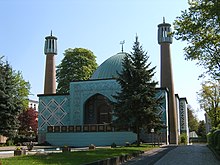Islamic Centre Hamburg
| المركز الإسلامي في هامبورغ Imam Ali Mosque Hamburg | |
|---|---|
 Imam Ali Mosque Hamburg | |
| Religion | |
| Affiliation | Islam |
| Location | |
| Location | Uhlenhorst, Hamburg, Germany |
| Geographic coordinates | 53°34′28.45″N 10°00′30.30″E / 53.5745694°N 10.0084167°E |
| Architecture | |
| Architect(s) | Architekturbüro Schramm und Elingius |
| Type | Mosque |
| Completed | 1961, 1963–65 |
| Construction cost | 2 Million Deutschmark |
| Specifications | |
| Capacity | 1500 |
| Dome(s) | 2 |
| Minaret(s) | 2 |
| Minaret height | 16 m |
| Website | |
| www.izhamburg.com/ | |
The Islamic Centre Hamburg (German: Islamisches Zentrum Hamburg) is one of the oldest mosques in Germany and Europe. Established in Hamburg, in northern Germany, in the late 1950s by a group of Iranian emigrants and business people it rapidly developed into one of the leading Islamic centres in the Western world.
Many leading Iranian theologians and politicians (including Ayatollah Beheshti, Ayatollah Mohammad Mojtahed Shabestari or Mohammad Khatami) have spent time (often years) here, have encountered and studied Western sciences and philosophy and contributed to the Western understanding of Islam.
History
During a meeting at Atlantic Hotel (Hamburg) in 1953, a group of Iranian residents of Germany discussed the need to establish their own religious center. A letter was sent to the late Grand Ayatollah Seyyed Husayn Borujerdi asking him for help; Grand Ayatollah agreed with the plan and donated 100,000 Rials to the center. The construction began in 1960 and by 1965 it was completed. In the same year Ayatollah Mohammad Beheshti was appointed to lead the center.
During the 1970s the centre played a significant role in bringing about the political rising of Iranian students in the West against the Shah and ultimately contributed to the Iranian Revolution.
In 2007, the center announced the launch of first Shia Union in Europe.[1]
Directors
- Hojjatulislam Mohagheghi (1955–1965)
- Hojjatulislam Mohammad Beheshti (1965–1970)
- Hojjatulislam Mohammad Mojtahed Shabestari (1970–1978)
- Hojjatulislam Mohammad Khatami (1978–1980)
- Hojjatulislam Mohammad Reza Moghaddam (1980–1992)
- Hojjatulislam Mohammad Bagher Ansari (1992–1998)
- Hojjatulislam Reza Hosseini Nassab (1999–2003)
- Hojjatulislam Seyyed Abbas Hosseini Ghaemmaghami (2004–2009)
- Hojjatulislam Reza Ramezani Gilani (2009–2018)[2][3]
- Hojjatulislam Mohammad Hadi Mofatteh (August 2018–Present)[4]
See also
References
- ^ 1st Shia Union launched in Europe Press TV, April 22, 2007
- ^ "Archived copy". Archived from the original on 2012-07-30. Retrieved 2012-09-05.
{{cite web}}: CS1 maint: archived copy as title (link) - ^ "Ayatollah Ramezani's mission in Hamburg ends". Tehran Times. 2018-07-31. Retrieved 2018-10-10.
- ^ WELT (2018-08-31). "Neuer Leiter des Islamischen Zentrums ist dialogbereit". Retrieved 2019-01-15.
External links
- Official website (in German)
- Official website (in English)
- A brief history, Hamburg Islamic Center.


